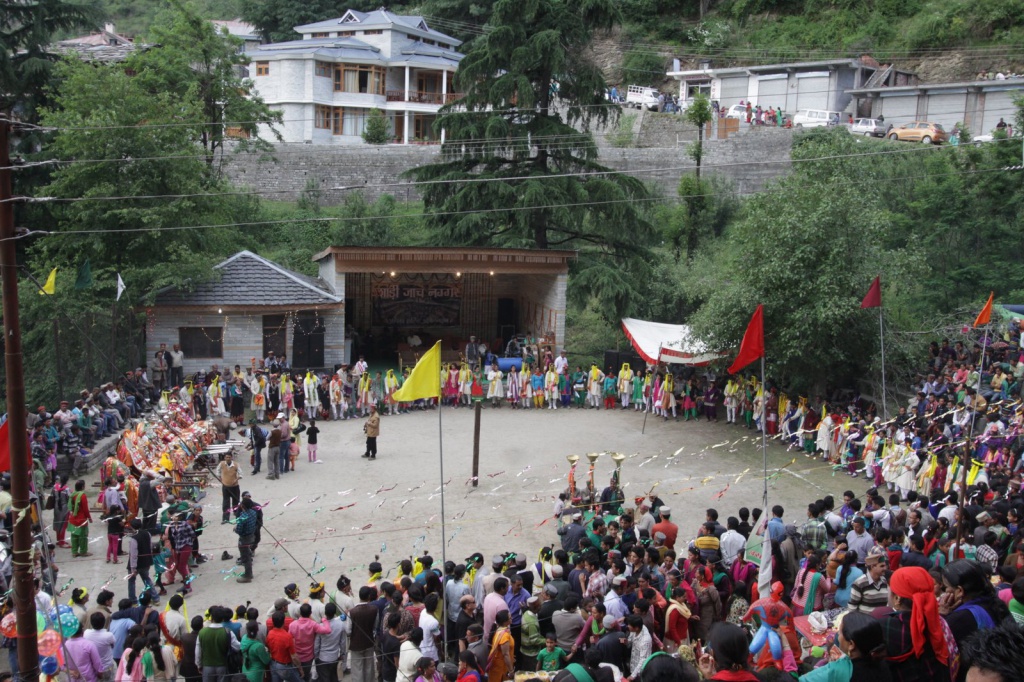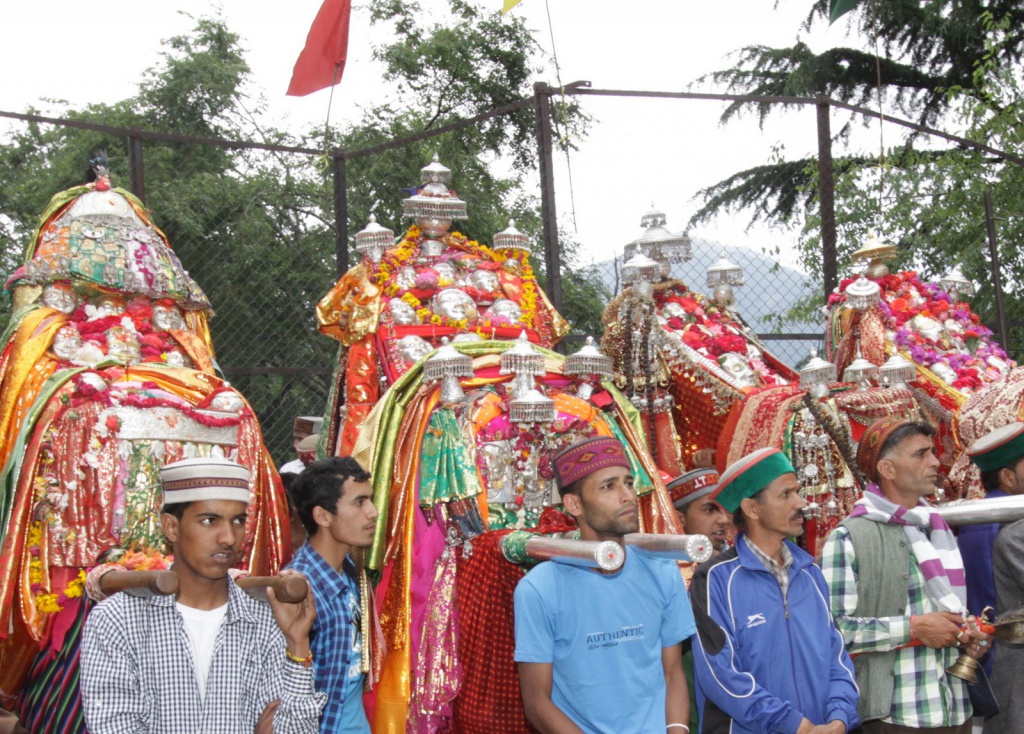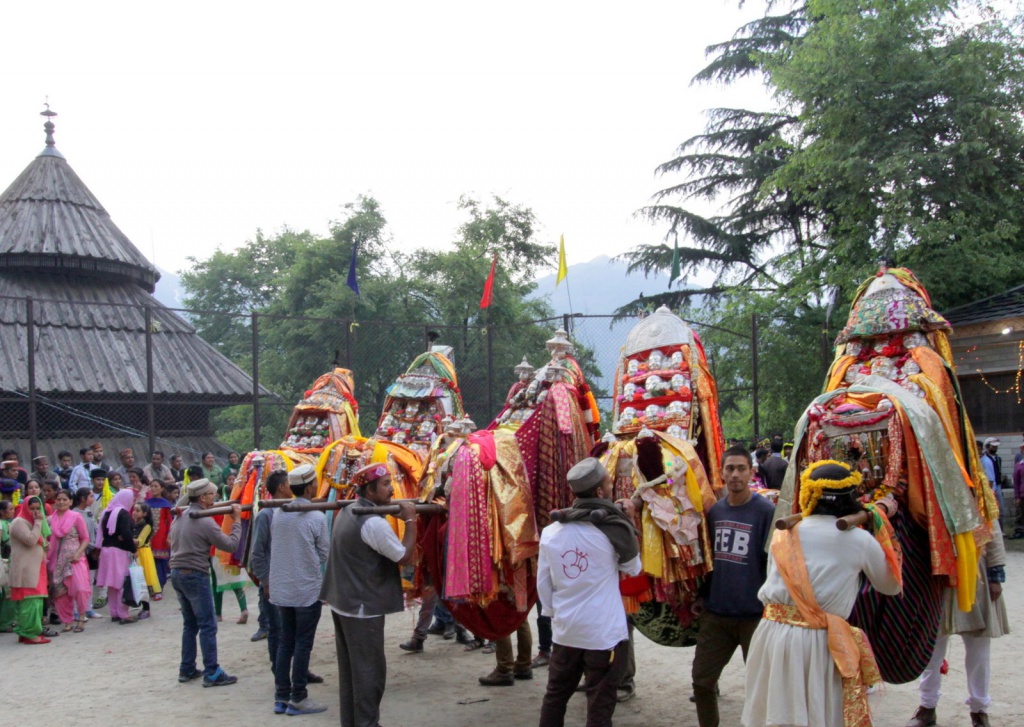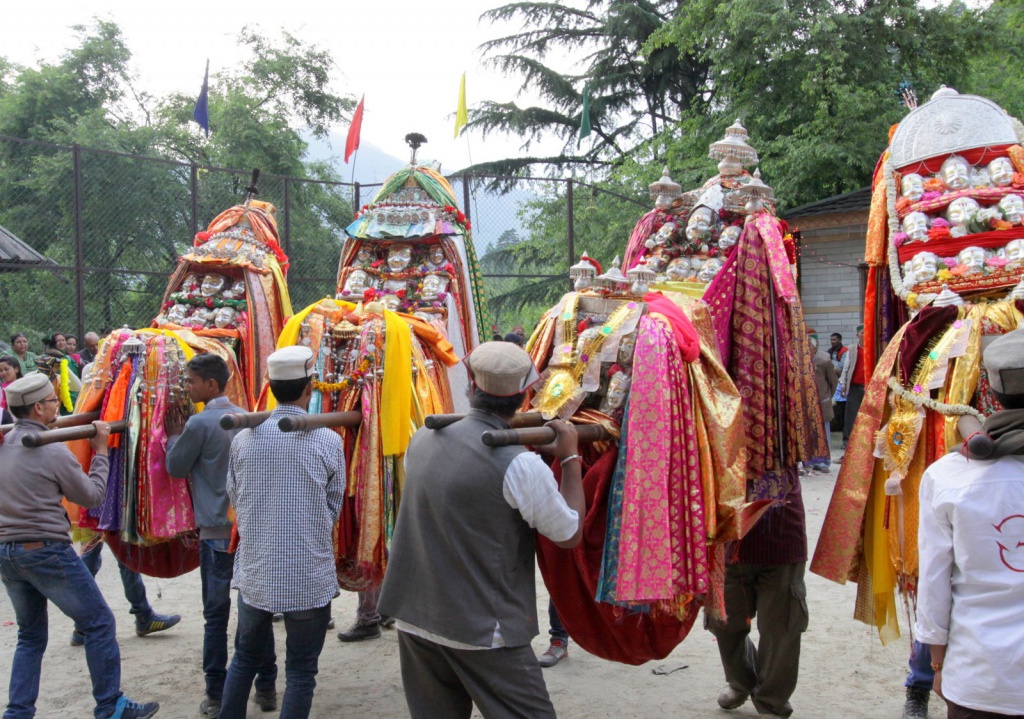Glimpses of Naggar Mela
Come month of May, and Naggar changes all over. On this month falls the Naggar Mela, the local fair and the most important event in the religious-cultural life of the village. It lasts for five days and usually starts on May 18. It marks the arrival of spring and subsequent beginning of new agricultural cycle, in celebration of which both men and gods gladly join.
According to Sriram, venerable pujari who has been conducting rituals in the Guga Chauhan temple on the territory of the Roerich Estate for many years, somewhere two thousand years ago, when there was no Naggar as such, people used to graze their cattle on the spot where now stands the famous temple dedicated to the goddess Tripurasundari. One day one of them (incidentally, Sriram’s ancestor) noticed that cows stopped giving milk in the evening. They suspected the cowherd of pilfering milk but he flatly denied it. To investigate the matter one of them followed the cows and noticed a beautiful girl aged around 3 sitting on the ground and drinking milk from the cow’s udder. But the moment he accosted her she disappeared. Next morning there appeared a rectangular stone on the spot where she was seen. Since that day the local people have been worshipping the goddess Tripurasundari and celebrating annual mela, and also had a temple erected in the memory of this miraculous encounter. It is also believed that Tripurasundari herself encourages the mela seeing it as an occasion for the local people to come together, make merry and spent time together in peace and harmony.
|
|

|
| The ground behind the Tripurasundari Temple where mela takes place | Nati – the main part of the cultural programme |
The mela opens with a fire ritual held in the morning of the first day. It is followed by the ceremonies conducted inside the Tripurasundari temple. Then the images of the main deities of Naggar (Tripurasundari herself, and Shehsnag and Bhatanti who arrive to the Tripurasundari temple on that occasion) are brought out in palanquins and placed on the dance ground behind the temple. Here in the subsequent days they are supposed to enjoy the spectacle and mingle with the guest deities. The first day of the festival closes with deo-khali, or sword dance performed by the local gur (shaman) in front of the deities’ palanquins. This is a sacred deed and can be performed only by him. Moreover, it has to be performed in all circumstances. For instance, this year gur had to dance half-naked in the rain.
|
|

|
| The band and the nati dancers | The Nati dancers including the women of Malana |
Each day of the mela participants join in a local dance of the Kullu valley, nati. However, it is not a common nati that is performed on this occasion, but a slower version of it, the so-called dhili nati. The dance starts in the afternoon and continues till sunset. On the first several days of the mela it is performed by men and on the last three days is joined by women from Malana who do it of their own accord. During the nati the performers sing in chorus illustrating the dialogue between lovers. The dance is led by a core group of nati performers who have this privilege and come from the families that have been performing it for decades, if not more. It is a lovely sight. While women dress in picturesque versions of local shawls (patu), men’s costume consists of topa (cap with dangling flower garlands) decorated with kalgi (a set of two pheasant feathers fixed on a cap, which has become quite expensive of late due to the ever increasing rarity of the Himalayan pheasant), choru/chola (shirt), patka (sash), gacchi (belt), churidar suthnu (long pyjamas with multiple folds). Traditionally the dancers wore pullha (shoes made of grass bearing local pattern). However, nowadays there are no special shoes worn on the occasion, the only restriction being that they should not be made of leather.
To add spunk to the show there is a jester (svang) complete with a comic mask and having fern leaves dangling on every side. He imitates the dancers or even joins them, entertains them and cracks jokes. During the first two days of the mela he wore woman’s outfit to the amusement of the onlookers. Like many other occupations at the mela it is hereditary.
|
|
|
| Deities arriving at the Mela venue | Deities greet each other |
The dance is performed to the tunes of a band consisting of about three trumpeters, five drummers and two pipers. It is supposed to be a sacred act and mala, or dance circle is not open to all.
The host deities are taken to the dance ground every morning and retire after the end of festivities. On the last day of the mela arrive the guest deities from other parts of the valley. These do not stay in Naggar and depart as soon as the mela is over. Usually around twenty deities visit Naggar mela but this year there were not more than ten. The guests arrive as it becomes them: in decorated palanquins with much pomp.
On arrival the host deities “greet” them: two palanquins come close and hug each other as it were. After that they take their place by the host deities forming a line and enjoy the nati performance unfolding before their eyes. This year the major guests were Chamunda Devi from Nashala and Ganesha from Ghordaur. Mahadev from Larankelo (Larain Mahadev), one of the major deities of the valley, was unfortunately absent (he visits Naggar Mela once in three years). When present, he normally sits separately from other deities: after all he is a yogi and should practice seclusion. Most deities have a gur and it is he who after the consultation with the deity announces whether it will attend a particular mela or not.

|

|
| The Kullu valley deities assembled | |
The palanquins are studded with locally made masks, mostly silver ones and covered with colourful cloths. Masks are the most powerful part of the deity and therefore should not be touched. They are manufactured by particular people and each time it is a long process involving a number of moral and physical restrictions imposed on the craftsman.
Deities travel in palanquins and it is believed that it is the deity that decides where to go and at what speed. The palanquin is carried by men, mostly young, while women are not allowed to do it. The palanquin carriers claim that it is the deity that directs them and sets the pace. They say that when the deity wishes to move they feel a jerk and then start moving guided and propelled by some unknown force. The travelling deity is accompanied by the gur (provided it has one), the pujara (priest) and kardar (the organizer of the trip who looks after its material aspect). No restrictions are imposed on the palanquin carriers during the trip, except for those that are considered obvious: no smoking, no drinking, no sexual intercourse.

|
|
| Deities dancing at the Mela |
The travelling deity may choose to suddenly stop and refuse to go any further. It may happen in the proximity to some important shrine, which is then interpreted as the deity’s desire to pay obeisance (this happened during the Naggar mela this year when the host deities returning from the ceremony to their temple suddenly stopped while passing by the ancient Gauri-Shankar temple). When this happens the pujara approaches the front portion of the palanquin and tries to “reason” with the deity. If it happens in the village, then the respectable male villagers approach it entreating it to proceed. After some time it works.
All the while it is believed that it is the deity that decides where to stop and for how long. The local people explain it thus: deities are like children and should be treated as such. They sulk, take offence, may bear grudges. For instance, certain deities never leave their village temple and therefore never attend melas. They may also be selective. For instance, while the chief deity of Naggar Tripura Sundari always attends Dussehra in Kullu, the main festival in the Kullu valley, but Sheshnag never does that. Likewise, Vasuki, the deity of the neighbouring village of Halan, never comes to Naggar. There may be some old story explaining it, but it is almost forgotten today and nobody really knows why Vasuki refuses to take part in Naggar mela. But his not coming to Naggar has already become a tradition that no one questions.
On the last day of the mela, when the guest deities have sufficiently amused themselves with the spectacle, all deities rise and start dancing. Forming a line roughly in the same order as they stand, the palanquins are slowly carried around the dance ground gently swinging to the rhythm of the drums. At the end of the day when the guest deities are about to leave the place, the host deities become emotional and try to prevent them from dying it, displaying their hospitality. It looks as follows: when the palanquin of some guest deity has starts moving and is about to leave the festival ground, the palanquin of the host deity suddenly blocks its way. This way the host deity is trying to say: «Don’t go just yet, stay some more!» Such a sweet display of affection makes deities even closer to humans. In Naggar preventing the guests from leaving is usually the duty of Sheshnag. This year however, Sheshnag himself refused to leave and repeatedly rushed back from the exit point to the corner of the festival ground which is believed to possess special power. Sheshnag’s palanquin bolted to that spot so fast that the participants of the nati performance had to scatter to avoid being crushed.
|
|
| Women of the Kullu valley enjoying the show |
Life in the Kullu valley very much rotates around these melas. Each such festival is also an occasion to visit one’s relatives and enjoy the spectacle. Naggar, too, is swamped with people making it difficult to walk along its lanes. Visitors, especially the womenfolk, dress up for the occasion, some of them displaying their traditional jewellery. One normally does not get to see such an abundance of gay colours in this small village.
The day after the mela local women come to the Tripurasundari temple to pray for prosperity. They dress up in unfastened patu and carry trays full of offerings (mostly flowers and incense). Normally the eldest woman from each house in Naggar (except for widows) should pay obeisance on that day. This is believed to bring peace and prosperity to her house. On that occasion they are allowed to touch the deities’ masks while applying vermilion.
After the festival the deities return to their temples, the palanquins are shifted to the storehouse near the temple (mandhar / bandhar) till the deity’s next outing, the tents are removed and nothing remains outside to remind one of the riot of colours and celebration that ruled this small village for almost one week and filled every heart with hope and happiness.